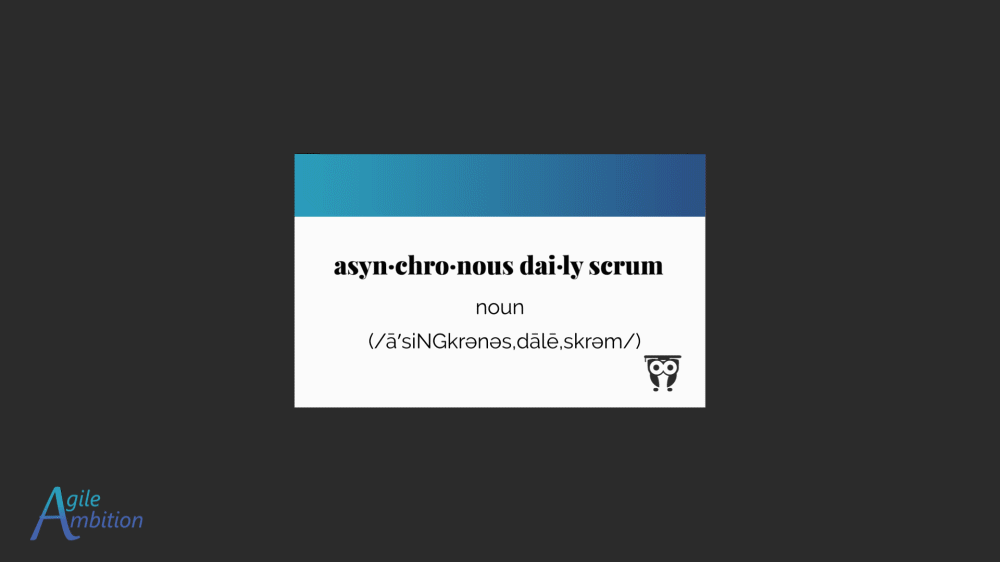Don't Let Async Standup Kill Team Effectiveness

The daily standup will either be the pulse that keeps team effectiveness alive or a nail in its coffin. Don’t let this event destroy your team’s effectiveness.
What Is Asynchronous Daily Standup?
An asynchronous meeting is a virtual meeting format often involving asynchronous methods such as messaging or email. Alternatively, synchronous meetings require everyone to meet simultaneously. Being in the same location is optional for synchronous meetings, as the team may meet remotely via video conferencing tools like Microsoft Teams or Zoom.
An asynchronous Daily Scrum refers to one of the Scrum ceremonies (the Daily Scrum) that the team runs through ad hoc messaging that does not require them to be available simultaneously. Asynchronous daily standups give teams a prompt to check in, but they are free to do this at a time that fits their schedule instead of a fixed time that might interrupt their focus.

A few apps have popped up over the last several years that focus on making asynchronous meetings easier, such as Geekbot and Friday. Teams may use these bespoke tools or existing messaging apps such as Microsoft Teams or Slack.
One team I worked on used Microsoft Teams to post a prompt for colleagues to answer the three Daily Scrum questions. The prompt was automated via Power Automate to prevent the need for human intervention to kick off the discussion.
The primary difference between asynchronous and synchronous meetings is whether you collaborate in real-time or leverage technology to communicate sporadically.
What Are the Benefits of Asynchronous Daily Standup?
Unlike the traditional “face-to-face” method of team meetings, an asynchronous daily standup allows teams to stay connected across multiple time zones without worrying about scheduling constraints.

Some people consider the permanent documentation aspects of asynchronous daily standup meetings an advantage, as it can emphasize accountability and allow for following up on forgotten items. Though I caution against this activity as traditional perspectives of accountability can foster psychological danger, which has adverse effects that far outstrip any benefit of documentation. For some cultures, it’s a quick jaunt from mandated documentation to micromanagement.
An asynchronous standup allows all team members to communicate without needing a pre-determined moment, granting them the freedom to share information at their convenience. This freedom to respond when available grants the boon of reduced interruptions and improved concentration.
Before you take the plunge based on these advantages, you should consider the disadvantages. It’s crucial to weigh the pros and cons carefully before deciding whether an asynchronous daily standup is right for your team.
What Are the Disadvantages of Asynchronous Daily Standups?
Asynchronous daily standups should be a tool leveraged to ensure that team members are on the same page and aligned on their goals. But, in my experience, this tool can have disastrous consequences for agile teams.
One of the main disadvantages of asynchronous daily standups is that they reduce transparency. With the extra burden of typing, team members may communicate less openly about their day, and there can be fewer moments for spontaneous collaboration.
Additionally, asynchrony can negatively impact focus, requiring the development team to check in periodically for pertinent updates. Thus, it takes extra effort to stay up to date on one another’s work and find opportunities for collaboration.
Without face-to-face communication, teams can find themselves at risk of not achieving their Sprint Goal due to a lack of collaboration and the assumption that someone else has it all taken care of. Engagement levels within the team can also suffer as a result.
All these disadvantages can affect team morale and cohesion if left unchecked.
Asynchronous Daily Standups Decrease Team Interdependence
With asynchronous daily standups, essential conversations occur in isolation; there’s no opportunity to catch up on context or learn from one another via direct concurrent communication. Limiting real-time exchanges erode team morale and reduces collaboration. Additionally, this approach fails to capture real-time updates, which can halt progress or cause issues that only get identified far too late in the process.
Throughout my career, I’ve seen several teams set up in what I like to call the puppet master structure. The manager knows the big picture and holds the roadmap for the team. Then they break that down into tasks and assign those tasks to individuals. These individual contributors eventually produce a product, but their vision is limited only to what they’ve worked on. In many cases, they aren’t familiar with how their work contributes to the overall goal because their manager never informs them of the overall plan. They definitely don’t know what other people on their team are working on. Since the boss has decomposed the overall project into pieces, tailored to ensure no dependencies exist, the team members don’t even need to be aware of each other.

This lack of awareness and knowledge transfer means the team can’t function effectively without their manager. This dependency creates a bottleneck that puts the business at risk.
Alternatively, interdependent teams work together to build and understand the plan so that everyone can cover for each other in case of absence. Collaboration is critical for successful teams; knowledge transfer happens naturally when everyone works towards a single goal and understands the big picture.

The Scrum Guide implies that teams should be interdependent, and synchronous Daily Scrums are necessary to keep everyone aligned if the group functions as described.
If your team is not interdependent, you have more pressing issues to address than the format of your Daily Scrum. Rather than worrying about the structure of the meeting, focus on removing any impediments preventing your team from working together in harmony.
Asynchronous Daily Standups Circumvent the Purpose as Defined in the Scrum Guide
Asynchronous Daily Scrums can circumvent the purpose as defined in the Scrum Guide.
“The purpose of the Daily Scrum is to inspect progress toward the Sprint Goal and adapt the Sprint Backlog as necessary, adjusting the upcoming planned work.”
- Scrum Guide
Another quote from the Scrum Guide tells us:
“The Developers can select whatever structure and techniques they want, as long as their Daily Scrum focuses on progress toward the Sprint Goal and produces an actionable plan for the next day of work.”
- Scrum Guide
Asynchronous daily standups fail to provide the necessary synchronous communication for constructing a unified plan. Furthermore, individuals render inspection of progress towards the Sprint Goal useless when the team attempts to solve the same problem at different times - an exercise in futility.
Discover Better Ways of Working
The biggest problem with asynchronous Daily Scrum is that they can easily lead team members astray from the Sprint Goal. Without a regular conversation about how individual tasks relate to the overall goal, it’s difficult for teams to stay on track and progress toward completion. Synchronous standups, however, require everyone in the meeting to actively discuss progress and changes against their plan - thus ensuring that everyone remains focused on the big picture.
The Daily Scrum should be a synchronous conversation about progress toward the Sprint Goal and how individual tasks contribute - something made way more cumbersome, if not entirely impossible, with asynchronous standups.

Asynchronous Daily Standups Introduce Inefficiencies
Dynamic, real-time discussion enables efficiency, which is lacking in asynchronous daily standups. The ad hoc nature of these meetings slows or mutes communication which may distort understanding. Team members won’t be able to act on their ideas immediately or adjust the plan based on appropriate feedback from other team members.
Additionally, if we’re trying to stay up to date and ensure that other team members aren’t blocked, we’ll need to keep an eye on this thread throughout the day as other members provide their updates at random intervals. This increases the number of interruptions a developer will experience throughout the day and decreases focus, which is one of the five Scrum values and something we should be looking to maximize.
Cal Newport proposes that one of the primary causes of burnout in knowledge workers is this asynchronous form of communication. This type of communication creates a situation where we have threads out in the ether that anyone can reply to at any time. When someone does reply, we must also respond, leading to an extended period of back-and-forth replies that take away from our focus and productivity.
The Agile Manifesto signatories understood the issue of asynchronous communication when they agreed upon the following principle:
“The most efficient and effective method of conveying information to and within a development team is face-to-face conversation.”
- Agile Manifesto
If we all convened at the same time each day, we could limit the chaos of unexpected updates and changes to our plan - allowing us to have a solid plan for the next day that everyone is aware of and can work towards. Asynchronous standups, however, allow for updates to be added at any point throughout the day, which can lead to confusion and rework.
This ad hoc style of communication also introduces a lot of context shifting. The Harvard Business Review backs up Cal’s stance and cites excessive collaboration as one of the main reasons for burnout and points out that the costs of context shifting are well documented.
”[S]witching to a new task while still in the middle of another increases the time it takes you to finish both tasks by 25%. A Microsoft study found that it takes people an average of 15 minutes to return to an important project after an email interruption.”
Cal goes as far as to suggest that one should be willing to go through whatever insane amounts of effort are required to meet face-to-face, and the efficiency of that interaction will outweigh the effort to establish it.
(skip to the 10:28 mark)Asynchronous Daily Standups: One Step Away from Abandonment
Asynchronous daily standups are too easily ignored and are often one step away from the altogether abandonment of the event. If people think it’s just a waste of their time, they will ignore it — meaning the standup has essentially become irrelevant.
A consistent daily mandate to encourage participation from all members maybe be one way to work around this. Still, the time investment in stalking developers that forget to respond will quickly add up. Spending more time managing responses than having a quick fifteen-minute synchronous meeting can be counterintuitive and lead to less productivity.
You may wonder, if the team isn’t getting any value from the Daily Scrum, why not abandon it? The reason is that done correctly, this event should provide value.
Teams often rely too heavily on the daily standup questions initially recommended in the Scrum Guide. When a team blindly answers these questions without understanding the purpose of the Daily Scrum, this can transform the event into a status meeting, which is a dysfunction, not the intended purpose.
This common misapplication of the questions eventually led to their removal in the 2020 update to the Scrum Guide.
If the team doesn’t find the meeting helpful, I’d question how they’re accomplishing the purpose of the Daily Scrum. If they’re not, this is a problem. Instead of avoiding the ceremony altogether, try a different format or approach that provides value.
Asynchronous Daily Standups Obfuscate Team Problems
The next qualm I have with asynchronous Daily Scrums relates to the many teams I’ve watched using them to mask a more significant problem. In an episode of the Agile Mentors podcast, Brian Milner told a story of a team that decided to abandon their Daily Scrum, as they felt it was a waste of time, and after attending one, Brian agreed.
He convinced them, however, that to avoid drawing attention from other agile teams, they should still gather in the conference room for 15 minutes as if they were running the event. Instead of doing the Daily Scrum, the team would talk about anything they needed to discuss to plan for the day’s work.
The team found this planning time incredibly useful and were so glad they decided to kill the Daily Scrum; otherwise, they never would have unlocked this opportunity to solidify their plan for the next 24 hours.
After a few days, Brian eventually revealed that what they now loved and found so much value in was actually a Daily Scrum - what they’d been doing before was an ineffective status meeting.

There are several dysfunctions that agile teams might have, which will make the Daily Scrum less valuable than it could be. Changing the Daily Scrum to account for these dysfunctions only sweeps the problems under the rug. Teams that switch to an asynchronous Daily Scrum to compensate for a deeper issue are misplacing their efforts and obfuscating the real problem.
Asynchronous Daily Standups remove face-to-face communication
When no face-to-face communication is involved, it’s hard to develop real commitment or expressions of emotions—which can make it challenging to create a sense of collective ownership and work together toward a common goal.
A significant drawback of asynchronous daily standups is that they lack the immediacy and personal connection of a synchronous meeting. Building trust and fostering collaboration among team members can be difficult without the ability to interact in real time.
Don’t be too quick to underestimate the benefits of human interaction.
Works Consulted
- How to get Scrum Teams comfortable asking for help
- Agile Mentors Podcast #6: How to make the Daily Scrum more effective with Julie Chickering
- A World Without Email
- Scrum Guide
- Agile Manifesto Principles
- The Five Dysfunctions of a Team
- Employee Burnout Is a Problem with the Company, Not the Person
- Cal talks about Conversational emails
- Disruption and Recovery of Computing Tasks: Field Study, Analysis, and Directions
TLDR
Asynchronous standups simply can’t do the job when it comes to providing direction and creating concrete plans for success. Without face-to-face interaction, it’s more difficult for team members to gain clarity about what needs to be done and when.
If you’ve given up on synchronous Daily Scrums and haven’t found any other means of accomplishing the intended purpose of this event, you should start writing the epitaph for your team’s efficiency.
Share
Table Of Contents
Buy Me a Coffee
Are you gaining value and insights from Agile Ambition? If you love what you're learning and want to see more, here's a simple way to show your support. Click the "Buy Me a Coffee" button to make a small donation. Each coffee you buy fuels our journey to discover better ways of working by unpuzzling Agile, one piece at a time.
Buy Me a CoffeeRelated Posts
Quick Links
Legal Stuff

